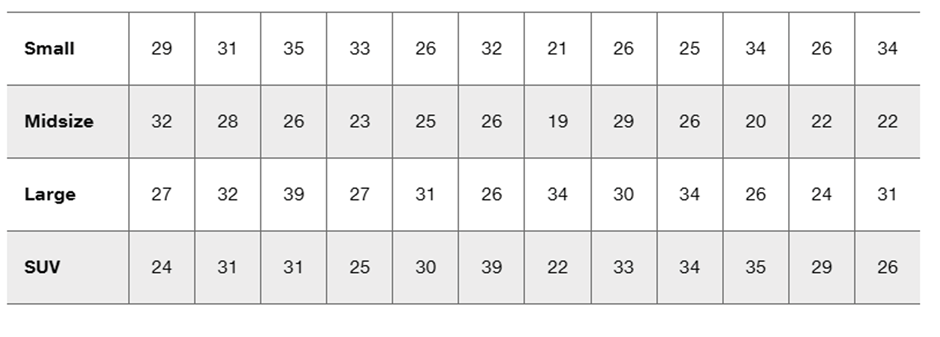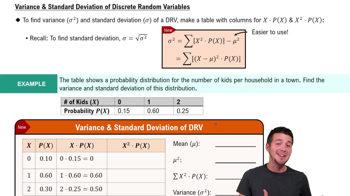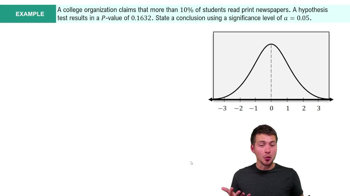Sitting Heights The sitting height of a person is the vertical distance between the sitting surface and the top of the head. The following table lists sitting heights (mm) of randomly selected U.S. Army personnel collected as part of the ANSUR II study. Using the data with a 0.05 significance level, what do you conclude? Are the results as you would expect?
Table of contents
- 1. Intro to Stats and Collecting Data1h 14m
- 2. Describing Data with Tables and Graphs1h 55m
- 3. Describing Data Numerically2h 5m
- 4. Probability2h 16m
- 5. Binomial Distribution & Discrete Random Variables3h 6m
- 6. Normal Distribution and Continuous Random Variables2h 11m
- 7. Sampling Distributions & Confidence Intervals: Mean3h 23m
- Sampling Distribution of the Sample Mean and Central Limit Theorem19m
- Distribution of Sample Mean - Excel23m
- Introduction to Confidence Intervals15m
- Confidence Intervals for Population Mean1h 18m
- Determining the Minimum Sample Size Required12m
- Finding Probabilities and T Critical Values - Excel28m
- Confidence Intervals for Population Means - Excel25m
- 8. Sampling Distributions & Confidence Intervals: Proportion1h 12m
- 9. Hypothesis Testing for One Sample3h 29m
- 10. Hypothesis Testing for Two Samples4h 50m
- Two Proportions1h 13m
- Two Proportions Hypothesis Test - Excel28m
- Two Means - Unknown, Unequal Variance1h 3m
- Two Means - Unknown Variances Hypothesis Test - Excel12m
- Two Means - Unknown, Equal Variance15m
- Two Means - Unknown, Equal Variances Hypothesis Test - Excel9m
- Two Means - Known Variance12m
- Two Means - Sigma Known Hypothesis Test - Excel21m
- Two Means - Matched Pairs (Dependent Samples)42m
- Matched Pairs Hypothesis Test - Excel12m
- 11. Correlation1h 6m
- 12. Regression1h 50m
- 13. Chi-Square Tests & Goodness of Fit1h 57m
- 14. ANOVA1h 57m
9. Hypothesis Testing for One Sample
Steps in Hypothesis Testing
Problem 12.1.2
Textbook Question
In Exercises 1–4, use the following listed measured amounts of chest compression (mm) from car crash tests (from Data Set 35 “Car Data” in Appendix B). Also shown are the SPSS results from analysis of variance. Assume that we plan to use a 0.05 significance level to test the claim that the different car sizes have the same mean amount of chest compression.

Why Not Test Two at a Time? Refer to the sample data given in Exercise 1. If we want to test for equality of the four means, why don’t we use the methods of Section 9-2 “Two Means: Independent Samples” for the following six separate hypothesis tests?

 Verified step by step guidance
Verified step by step guidance1
Step 1: Understand the problem. The goal is to test the claim that the four car sizes (Small, Midsize, Large, SUV) have the same mean amount of chest compression using a significance level of 0.05. The question asks why we don't use six separate hypothesis tests for pairwise comparisons of the means.
Step 2: Recognize the issue with multiple hypothesis tests. Performing six separate tests for pairwise comparisons (as shown in the hypotheses H₀: μ₁ = μ₂, H₀: μ₁ = μ₃, etc.) increases the risk of Type I error. This means the probability of incorrectly rejecting a true null hypothesis increases with the number of tests conducted.
Step 3: Introduce the concept of ANOVA (Analysis of Variance). ANOVA is a statistical method designed to test for equality of means across multiple groups simultaneously. It controls the overall Type I error rate and is more efficient than conducting multiple pairwise tests.
Step 4: Explain the mechanics of ANOVA. ANOVA compares the variability between group means to the variability within groups. If the between-group variability is significantly larger than the within-group variability, we reject the null hypothesis that all group means are equal. The test statistic is based on the F-distribution.
Step 5: Highlight the advantage of ANOVA. By using ANOVA, we can test the equality of all four means in a single test, avoiding the need for six separate tests and reducing the risk of inflated Type I error. If ANOVA indicates significant differences, post-hoc tests (like Tukey's HSD) can be used to identify which specific means differ.
 Verified video answer for a similar problem:
Verified video answer for a similar problem:This video solution was recommended by our tutors as helpful for the problem above
Video duration:
3mPlay a video:
Was this helpful?
Key Concepts
Here are the essential concepts you must grasp in order to answer the question correctly.
Analysis of Variance (ANOVA)
ANOVA is a statistical method used to test differences between two or more group means. It helps determine if at least one group mean is significantly different from the others, which is essential when comparing multiple groups, such as different car sizes in this case. By using ANOVA, we can avoid the increased risk of Type I error that occurs when conducting multiple t-tests.
Recommended video:
Guided course

Variance & Standard Deviation of Discrete Random Variables
Null Hypothesis
The null hypothesis is a statement that there is no effect or no difference, serving as a starting point for statistical testing. In this context, the null hypothesis posits that the mean chest compression is the same across all car sizes. Testing this hypothesis allows researchers to determine if observed differences in means are statistically significant or due to random chance.
Recommended video:
Guided course

Step 1: Write Hypotheses
Significance Level
The significance level, often denoted as alpha (α), is the threshold for determining whether to reject the null hypothesis. A common significance level is 0.05, indicating a 5% risk of concluding that a difference exists when there is none. In this scenario, using a 0.05 significance level means that if the p-value from the ANOVA test is less than 0.05, we would reject the null hypothesis and conclude that at least one car size has a different mean chest compression.
Recommended video:
Guided course

Step 4: State Conclusion Example 4

 6:21m
6:21mWatch next
Master Step 1: Write Hypotheses with a bite sized video explanation from Patrick
Start learningRelated Videos
Related Practice
Textbook Question
